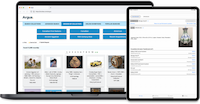7 Digital Storytelling Elements That Live In Your Museum CMS

Rachael Cristine Woody
For those new to digital storytelling and online museum exhibit design, the first tool to test story delivery is the museum Collections Management System (CMS). The benefit of beginning with a museum CMS is that object data and representative images are largely available.
While not strictly a storytelling platform, the CMS can offer an introductory environment within which museum staff can experiment and find storytelling inspiration. This post will evaluate how different digital surrogate types can aid in story crafting.
Digital Items as Storytelling Elements in Your Museum CMS
As museum professionals, it can be difficult to view artifacts in a capacity separate from care, management, and access. However, each has strengths as story elements, and understanding the potential for each type is important for translating exhibits to the digital realm and successful digital story creation.
For example, digitized collection items can be incorporated into the following storytelling performance types:
- Oral: Narration, oration, recitation, interviews, conversation
- Written: Exhibit panels, documents
- Visual: Objects, drawings, graphics, photographs, visual media
The following digital item types serve as excellent storytelling elements for museum collections online:
- Artifacts and 3D Items
- Journals and Correspondence
- Newspapers
- Architectural and Location Documentation
- Photographs
- Oral Histories and Other Interviews
- Music
Artifacts and 3D Items
While artifacts and most 3D items are the stars of the show in an exhibit layout, the items tend to serve primarily as props or examples for the story. In some cases, the artifacts can deepen an area of understanding within the story, but when compared to other materials, artifacts aid in storytelling in a simple and straightforward way.
Journals and Correspondence
Journals and correspondence often provide great insight into a person’s life. Both mediums are known for capturing private thoughts—big and small. Despite any number of years since the writing, there are always aspects of the shared content that resonate with the present-day reader.
Newspapers
Articles and even advertisements serve as authentic time capsules. Coverage regarding events of the day—everyday interests and concerns, and even the price of groceries— is filled with historical information and a sense of the people living at that time. Instead of a 1-on-1 element (e.g., correspondence), newspapers instead present information at the macrocosm level.
Architectural and Location Documentation
Schematics, sketches, plat maps, and other structural documentation support the establishment of space and time. Space in the literal sense is provided by sharing the structure, shape, and size of a building or location. Time in the sense that any documentation for a particular area or building is a snapshot in time, and depending on age, has likely evolved over the decades or even centuries since the creation of the documentation in hand.
Photographs
Visual items are powerful storytelling elements because the items can offer visuals for a story the brain may otherwise have a hard time imagining. Photographs are visuals for people, places, and events—and can offer a large amount of contextual information. In addition to being evocative and supreme empathy connectors, photographs also telegraph information pertinent to the story.
Oral Histories and Other Interviews
Interviews offer unique insight into the interviewee, especially when they respond to questions that inspire introspection and vocalization of thoughts not already broadly shared with the public. Interviews as a medium can be audio-only or audio-visual. Using an interview clip to illustrate a portion of the story can be powerful, especially when a person integral to the story can share a first-hand account of a person, place, event, or thing.
Music
All forms of music—for fun or for ceremony—offer another sensory element to help set the scene as well as deliver subtle amounts of information. Music is known to convey emotions, tell stories, and speak to the thoughts and concerns of the day. As both scene setting and a vehicle for information delivery, music is an option to help enhance the overall story experience or to be deployed at specific points in the story.
Enabling Digital Access Starts with a Flexible Museum CMS
For items that exist in a physical sense, photography or other forms of digitization are necessary in order for the item to have a digital surrogate. Some of these materials may already be born-digital, in which case a digital access copy for the story can be easily incorporated.
When considering the CMS for an introductory foray into digital storytelling, you’ll want to make sure digital surrogates of the materials outlined above are available in your museum CMS.

Rachael Cristine Woody
Curious about this topic? Please join us for the companion webinar, Collections Online as Storytelling Elements on February 26, 2025 at 11 a.m. Pacific, 2 p.m. Eastern. (Can’t make it? Register anyway and we will send you a link to the recording afterwards.) Register now or call 604-278-6717.
**Disclaimer: Any in-line promotional text does not imply Lucidea product endorsement by the author of this post.
Never miss another post. Subscribe today!
Similar Posts
Exploring No-Code Digital Storytelling: Hoover’s “Fanning the Flames” Exhibit
Explore no-code digital storytelling with Hoover’s ‘Fanning the Flames’ exhibit. See how interactive tools (Deep Zoom Color Compare & Hot Spot) enhance user engagement and the visual experience.
An Introduction to Scrollytelling for Museums
Discover how museums use scrollytelling and digital storytelling platforms to create immersive narratives. This introduction explores key concepts and approaches to interactive storytelling.
Exploring Self-Determinate Multiple Pathways: An Example of Digital Storytelling
Discover how self-determinate multiple pathways offer flexible interactive storytelling in museum exhibits. Learn from the Tenement Museum’s ‘Your Story Our Story.’
Digital Museum Storytelling Example: A Look at Self-Determinate Linear Pathways
Self-determinate characteristics on a linear pathway go beyond brief sidebar topics and instead offer alternative ways to navigate the linear pathway.







Leave a Comment
Comments are reviewed and must adhere to our comments policy.
0 Comments